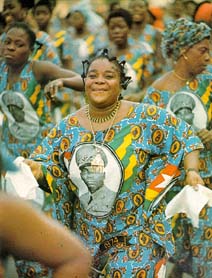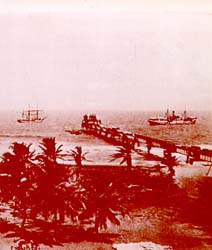

HISTORY AND GOVERNMENT
 The
Ewes, who were hunters and farmers, moved into the area which is now Togo
from the Niger River Valley between the 1100's and 1300's centuries. During
the 1400's and 1500's centuries, Portuguese explorers and traders visited
the coast. For the next 200 years, the coastal region was a major slave
trading center. To a great extent, the history of modern Togo mirrors the
history of colonial Africa, as European powers struggled to gain control
of overseas territories.
The
Ewes, who were hunters and farmers, moved into the area which is now Togo
from the Niger River Valley between the 1100's and 1300's centuries. During
the 1400's and 1500's centuries, Portuguese explorers and traders visited
the coast. For the next 200 years, the coastal region was a major slave
trading center. To a great extent, the history of modern Togo mirrors the
history of colonial Africa, as European powers struggled to gain control
of overseas territories.
Over the years, Europeans established enclaves along the coast, and in 1884 a German diplomat, Gustav Nachtigal, arrived at a small village called Togo, which is today Togoville. On July 4th and 5th, 1884, the chief of Togoville, Mlapa III, signed a treaty with Nachtigal that quickly led to the creation of German Togoland.
Following Germany's defeat in World War I, the country was divided into two territories: West Togo came under British rule and is now part of the modern nation of Ghana. East Togo became a French territory - today's Republic of Togo. In 1956, Nicholas Grunitzky became prime minister of Togo, but lost to Sylvanus Olympio in a UN supervised general election in 1958. On April 27, 1960, French Togo became fully independent under a provisional constitution with Sylvanus Olympio as president. In 1963, President Olympio was assassinated by army noncommissioned officers, and Grunitzky returned to head a provisional government first as prime minister and later as president.
In April of 1967, President Gnassingbe Eyadema came to power as president. In 1972, a national referendum, in which President Eyadema ran unopposed, confirmed his presidency. In 1979, President Eyadema declared a Third Republic and a transition to a more civilian rule with a mixed civilian and military cabinet. He received 99.97% of the vote in uncontested presidential elections in 1979 and 1980. A new constitution also provided for a national assembly as a consultative body. President Eyadema was reelected to a third consecutive 7-year term in December 1986 with 99.5% of the vote in an uncontested election.
 Between
1989 and 1991, anti-government demonstrators and security forces clashed
in Togo. In 1991, the government negotiated with newly formed opposition
groups and agreed to a general amnesty permitting exiled political opponents
to return to Togo, and later agreed to hold a "national conference" later
that year.
Between
1989 and 1991, anti-government demonstrators and security forces clashed
in Togo. In 1991, the government negotiated with newly formed opposition
groups and agreed to a general amnesty permitting exiled political opponents
to return to Togo, and later agreed to hold a "national conference" later
that year.
The National Conference resulted in a draft interim constitution for a one year transitional regime followed by free elections for a new government. Kokou Joseph Koffigoh, a lawyer and leader of a human rights group, was selected as transitional Prime Minister, with President Eyadema as Chief of State with limited power during the transition.
In 1992, presidential and opposition representatives negotiated a new political agreement extending the transition period until the end of 1992 and restoring substantial power to President Eyadema. A third transition government was formed by Prime Minister Koffigoh with considerable participation by supporters of President Eyadema. The government was mandated to hold elections in the near future. The public overwhelmingly approved the text of a new, democratic constitution, formally initiating Togo's fourth republic.
In early 1993, President Eyadema's negotiations with the opposition led to the July 11 Ounagaaougou agreement setting forth conditions for upcoming presidential and legislative elections and ending a general strike in August 1993. The presidential elections were set forth for August 25, 1993 but hasty and inadequate logistical and technical preparations, concerns about possible fraud, and lack of effective campaign organization by the opposition, led primary opposition candidates to boycott the elections. President Eyadema won the election with 96.42% of the votes cast. About 36% of the voters went to the polls; the others boycotted.
Under President Eyadema's leadership, Togo has enjoyed over two decades of political stability and economic progress, except for the period 1990-1994 when the political transition to democracy caused a great deal of national strife. The president is elected by universal direct suffrage for a term of seven years and could be reelected.
The National assembly, consisting of 77 elected representatives, is the legislative branch of the government. Although Togo has a presidential system of government, the executive and legislative branches are complementary and work in close cooperation. The Togolese judiciary is modeled on the French system. For administrative purposes, Togo is divided into 30 prefectures, each having an appointed prefect.
With the adoption of anew constitution in 1992, Presidential and legislative elections in 1993 and 1994, and the installation of a freely elected national assembly and formation of a new government based on the legislative results, Togo is making steady progress in its democratization process.